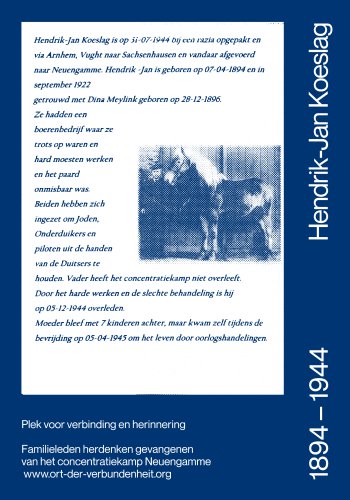Geschreven door Jan Braakman op 15-02-2020
Koeslag was een van de oprichters van het verzet in het Gelderse Laren.
Bij een doorzoeking op 30 juli 1944 bij drie van zijn broers en bij hem thuis, werden Hendrik Jan Koeslag en diens broer Albert Koeslag gearresteerd en afgevoerd. Albert Koeslag werd in augustus 1944 vanuit Arnhem vrijgekocht. Een derde arrestant, Jan Lamberts, werd vanuit Arnhem overgebracht naar Kamp Amersfoort. Hij kwam enkele weken later vrij.
Literatuur:
Jan Braakman; Klein Nederland - De Oorlog in een Gelders dorp; Aalten; 2010
Jan Braakman; The War in the Corner - Chronicle of a village in wartime Netherlands; Shawnigan Lake BC; 2012
W.H. Vermooten; Strijders zonder Uniform; Zutphen; 1945
Joh. E. Koeslag; Gebeurtenissen uit Laren tijdens den oorlog; Oolde; 1946
Hendrik Jan Koeslags echtgenote, Dina Koeslag-Meijlink, kwam op 5 april 1945 om bij de bevrijding van Laren (Gld). Zij werd dodelijk getroffen tijdens schermutselingen tussen Duitse en Canadese troepen.
Op de grafsteen van Dina Koeslag-Meijlink op de begraafplaats in Laren (Gld) staat dat Hendrik Jan Koeslag is overleden in Porta Westfalica. Deze informatie, destijds vernomen van een medegevangene, is waarschijnlijk onjuist. De medegevangene plaatste het overlijden van Koeslag in februari 1945. Volgens de dodenboeken van Neuengamme is Koeslag overleden op 5 december. Onderzoekers/deskundigen in Neuengamme achten het niet waarschijnlijk dat in de dodenboeken een fout is gemaakt of dat er sprake kan zijn van een persoonsverwisseling.
De kinderen van Koeslag hoorden in de zomer van 1945 via het Rode Kruis dat hun vader in Neuengamme was omgekomen.
Geschreven door Jan Braakman op 03-11-2020
The witness versus the documents
28-09-2012
Around September 5, 1944, my grandfather was transported from Konzentrationslager Herzogenbusch (also known as Vught, photo above) to Sachsenhausen. In October 1944 he was moved again, then from Sachsenhausen to Neuengamme. His wife and children were totally unaware about his whereabouts. Even long after the war had ended, when Hendrik Jan Koeslag did not return, his children were confused. Where was he? Where had he been? Was he still alive?
In the summer of 1945 the family placed an advertisement in the resistance newspaper Trouw requesting information. In July 1945 a labourer from the village of Winterswijk came forward with information. He told that he had known Koeslag, and had seen that Koeslag died in the German labour camp Porta Westfalica. How sad the message was, the children now had some sort of confirmation of what happened to their father. Later that year, the Dutch Red Cross informed the family with another message: father Hendrik Jan Koeslag had died in concentration camp Neuengamme, near Hamburg. Source of the information were the Sterbebücher of the concentration camp that were saved by prisoners. These ‘death books’ were considered reliable information - more reliable than the information of witnesses.
But could Hendrik Jan have been in a labour camp called Porta Westfalica?
Thomas Käpernick, who works for the Neuengamme memorial site, did some research. In Porta Westfalica were three ‘sub locations’ for the concentration camp Neuengamme: Barkhausen, Hausberge und Lerbeck. In Hausberge were no Dutch prisoners, according to the existing files. But there was exchange between Neuengamme and Barkhausen. Sometimes prisoners, who were not able to work anymore, were sent back to Neuengamme and replaced by ‘fresh’ prisoners.
Camp Lerbeck did have about 100 prisoners from October 1944. Prisoners did not have enough food, though the labour wasn’t too bad. But the camp commander Hagenah was very cruel. About 100 people lost their lives in Lerbeck.
Käpernick could not find a confirmation that Koeslag had been in one of the camps in Porta Westfalica, but at the same time, he also couln’t rule out this possibility.
It is possible that Riggelink saw Koeslag in one of the camps in Porta Westfalica, but certainly not in february 1945.
Riggelink probably was confused about the date, and he also wasn’t correct about the place of death - and the first name of Hendrik Jan.
Addendum October 23, 2020
Edwin Vrielink of the Digitaal Monument Neuengamme sent me an email in 2020 with some remarks, related to this blog post. He made me reconsider what I had written in 2012. My conclusion then was that Riggelink probably had mistaken Hendrik Jan Koeslag for someone else and that he mistakenly spoke about Jan Koeslag, although Koeslag was known as Hendrik Jan. I wrote: “It was not common in those days to use Jan as short for Hendrik Jan. And Koeslag had a brother called Jan, so it wouldn’t be logic for Hendrik Jan to be called Jan.”
Vrielink pointed on another fact: there was only one Koeslag in the Neuengamme files, so how could Riggelink mistakenly be speaking of the wrong Koeslag?
Vrielink added that the circumstances in the sub camps in Porta Westfalica were so harsh that prisoners lost a third of their weight within weeks. Some even didn’t recognize their own brothers anymore.
Another thing is that prisoners lost other inmates out of sight, and concluded that their companion had past away - that is what they told the relatives in the Netherlands after coming back from Germany. Sometimes new and different information in the form of documents popped up (as in the case of Hendrik Jan Koeslag) from official bodies like the Red Cross. Witnesses sometimes were blamed for giving wrong information, which made them more and more reluctant to come forward. They weren’t believed anyway, Vrielink wrote.
So Riggelink may be making a mistake about the given name, the date and place of death of Hendrik Jan Koeslag, that doesn’t mean that he did not see Koeslag in Porta Westfalica at any time before December 5, 1944.



